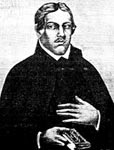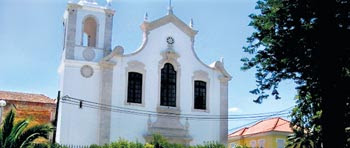
Portrait of Dom João in ecclesiastical costume

The Church of Our Lady of the Gate of the Heaven in Lisbon
Some years ago, I came across an interesting episode in our history that took place about four centuries ago while reading through Paul E. Pieris´s book, ´Ceylon of the Portuguese Era´ (1913), Fr. S. G. Perera´s work ´A History of Ceylon for Schools, the Portuguese and Dutch Periods´ (1949) and ´Historical Gleanings´ (1992) by Rt. Rev. W. L. A. Don Peter.
This story unfolded around the man who was known as a ´Black Prince´, one who belonged to the dynasty of the Kandyan kings but who later resided in Lisbon and erected a Franciscan church at Telheiras in the outskirts of Lisbon at his own expense. On a recent visit to Lisbon, I was determined to go to this church and that became a reality a week ago.
Before going to the church, I visited the library of the Geographical Society in Lisbon – Sociedade da Geografia da Lisboa and found there an interesting paper contributed by Sousa Viterbo to ´Archivo Historico Portugez´ (1905) with some relevant plates.
On a Sunday, at about 12 noon I took the metro to Telheiras without any clue of the exact location of the church concerned. But stepping out of the Metro station, on to the left, I could see the upper part of a church façade. This caught my attention and I walked along the path heading towards it. It took a considerable time to reach there as the surroundings of the church consisted of a beautifully landscaped garden with paved paths and a cluster of lush green trees. The long fountain by the side of the path attracted me, its water spouts making multiple patterns.
Approaching the church I noticed the members of the congregation entering the church for their weekly service and went in too. At the end I talked to the priest and though the conversation was not fruitful, it confirmed that the name of the church was ´Nossa Senhora da Porta do Ceo - Our Lady of the Gate of the Heaven’, and that it had been built some centuries ago by a Sri Lankan Prince who lived in Telheiras. He knew nothing more than that and directed me to contact some others to get more information.
This church was erected by a member of the Sri Lankan royal dynasty, the son of Yamasingha Bandara of Kandy who was baptised ´Dom João´. Here it took my memory back to a passage included in Fr. S. G. Perera´s above mentioned work, where it was stated ´Dom João had a villa and a chapel in which he was buried at Telheiras which are now in ruins´. The church would certainly have been damaged when a disastrous earthquake hit Lisbon in August, 1755. This monument would not have received much attention from the authorities at the time of the visits of Fr. Perera (1949) and Fr. Don Peter (1992). However, it is now a beautifully conserved building.
The inscription fixed on to the façade of the chapel above the main doorway indicates that ´it has been built by the Prince of Candia´ and was reconstructed subsequent to the earthquake mentioned above. The year recorded at the end of the text is MDCCLXVI (1766) which is approximately ten years after the earthquake.
Don Joao is known in Portugal as the ´Black Prince´. He lived in Telheiras and his remains were interred in this Franciscan chapel founded by him. His tombstone carried the inscription ´Quisacram hanc Mariae aedem fundavit hic Candiae Principis ossa Septiantur´ which says ´Here lie buried the remains of the Prince of Candia who erected this holy edifice in honour of Mary.
The story of this ´Black Prince´ takes us back to the time of the fall of Sitavaka and the emergence of the Kingdom of Kandy. This was the time that the Portuguese had a plan to conquer the whole of Sri Lanka. They were spurred on by their victory in the siege of Colombo between 1587 and 1588 and the fall of Sitavaka in 1594. At the turn of the century the Portuguese held control over the lowlands of the island and focused on conquering Kandy, the `Kingdom of Mountains´ with a view to ´extinguish the natural kings of the island´. The execution of this plan was left to the newly created position of ´Captain General of the Conquest of Ceylon´ to which Dom Jeronimo de Azevedo was appointed in 1595. The presence of the Dutch in the Indian waters was a prospective threat to their supremacy and the best remedy was to gain control of the entire island and close the gates to the Dutch. After the demise of Rajasinha of Sitavaka, a part of the plan of the Portuguese was to place Dom Philip Yamasinha on the throne in Kandy. Although he ascended the throne, he could not hold it as this aged man died shortly after paving the way for his twelve-year-old son Dom João to claim the throne. The rebel Konappu Bandara gave no opportunity for him to rule Kandy. He overthrew the prince immediately and proclaimed himself the King of Kandy with the name Wimaladharmasurya. All these happened contrary to the wishes of the Portuguese.
Dom Philip Yamasinha´s death in 1593 made his son Dom João an orphan and even excluded him from the kingdom of Kandy. To save his life, he left with his grandmother to Vahakotte with the help of the Franciscans. In no time he was sent to Mannar by Matheus Mendes de Vasconcellos supported by Friar Francisco de Oriente who provided the prince with fatherly love.
Dom João was subsequently brought to Colombo for further education and lodged at the college of St. Thomas and entrusted to Fr. Jeronimo de Espirito Santo. He had already looked after another prince, a grandson of Sitavaka Rajasinha called Nikapitiye Bandara who was baptised as Dom Philip. Nikapitiye had been captured at Denavaka with his grandmother while fleeing to the mountains.
Since both were of royal blood, their mentor considering the safety of the two princes decided to transfer them to the College of Reis Magos in Bardez in Goa which was a centre of the Franciscan Mission. There they stayed about fifteen years studying divinity and Latin. Fr. Vitto Perniola believes that they had left for Goa between May 1597 and December 1600 and arrived in Lisbon at the end of 1609 or 1610. (Catholic Church in Ceylon, vol. II, p. 149)
The Portuguese authorities in Lisbon were of the opinion that both of these princes should be brought to Portugal as ordained sub-deacons as they had completed their course of studies in Goa. A secure passage was arranged for them to travel to Lisbon in the company of Andre Furtado, who returned home after completing his term of office in Goa as the Governor.
At Lisbon they were received with great honour and provided with lodgings in the Convent of St. Francis. Later they were given an audience with the King of Portugal who in turn ordered them to be sent to the Royal College of Coimbra, one to St. Peter´s and the other to St. Paul´s and offered an annual grant of four thousand cruzados until they finished their studies to be qualified for Bishoprics.
Dom Philip (Nikapitiye Bandara) accepted the grant and proceeded to Coimbra where he died a few years later. Dom João declined the offer of the King and opted to stay in Lisbon. He requested that he be granted an income and status in conformity with his rank. The King acceded to the request and ordered an annual grant of four thousand cruzados from the Royal Treasury to be paid by India House (Casa da India). With this royal grant he decided to live in Telheiras which became his home until his death at the age of 64 in April 1642.
Paul E. Pieris refers to an escutcheon of his with a shield bordered by seven castles and showing the Sinhalese Lion rampant and the Sun from which he claimed descent supported by a tower crowned with the cross of Aviz. The shield supports a crown showing six flowers alternating with pearls. According to Paul E. Pieris, this was hanging on the wall of the Gospel side of the inner chapel. Such a thing however, cannot be seen at present. He also refers to a portrait depicting the bust of Dom João in ecclesiastical costume which has been removed from his Oratorio to the Biblioteca Nacional (National Library) in Lisbon. An enquiry from the Biblioteca Nacional revealed that it had disappeared long ago. This portrait of Dom João has been reproduced in Viterbo´s article referred to above, a copy of which is reproduced here.
The chapel had been the monument he thought fit to show his gratitude to the Franciscans who saved his life, looked after him well and provided him education. The adjoining monastery is also said to have been constructed by him for the Franciscans This remains to date with its ancient façade.
(http://www.sundaytimes.lk/070722/Plus/pls10.html)


